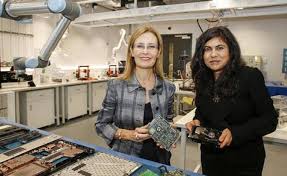Indian origin scientist develops world's first microfactory for e-waste
IIT-trained Australian scientist of Indian origin Veena Sahajwalla has launched world’s first microfactory that can transform components from electronic waste items into valuable materials for re-use.
Key Facts
The e-waste microfactory uses green manufacturing technologies to turn many types of consumer waste such as glass, plastic and timber into commercial materials and products. It is modular micro factory that can operate on site as small as 50 square metres and can be located wherever waste may be stockpiled. It has one or series of small machines and devices that uses patented technology to perform one or more functions in the reforming of waste products into new and usable resources.
Working: The e-waste microfactory has number of small modules for processing e-waste and fits into small site. The discarded devices are first placed into module to break them down. The next module involves special robot for identification of useful parts. Another module then involves using small furnace which transforms these parts into valuable materials by using precisely controlled temperature process developed via extensive research.
Use of e-waste: These transformed materials from the micro-factory includes metal alloys and range of micromaterials. These can be used in industrial-grade ceramics and specific quality plastics from computers, printers and other discarded sources can be used to produce filaments suitable for 3D-printing applications. The metal alloys can be used as metal components for new or existing manufacturing processes, she said.
Significance
The e-waste microfactory has the potential to reduce the rapidly growing problem of vast amounts of e-waste causing environmental harm and going into landfill. It offers a cost-effective solution to one of the greatest environmental challenges of our age. The microfactory presents solution to burning and burying waste items that contain valuable materials that can be transformed into value-added substances and products to meet existing and new industry and consumer demands
Month: Current Affairs - April, 2018


